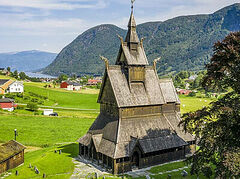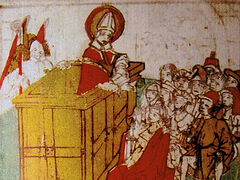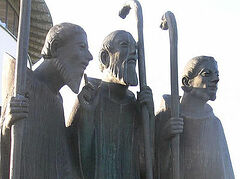Part 1: Early Figures, Missionaries, and Martyrs
Part 2: Holy Hierarchs
Part 3: Hermits and Ascetics
St. Wandregesilius of Fontenelle (†668)
St. Philibert of Jumièges (†c.684)
St. Leufroy of Évreux (& his brother St. Agofredus) (†738)
During Frankish times, specifically the Merovingian period, great monasteries were established that were to have a profound and lasting influence on the spiritual life and development of the Normandy region. Writing of those times and of the exploits of the holy founders of Normandy’s monastic centers, Orderic Vitalis, a 12th-century English-born Norman chronicler, summed matters up as follows:
The shoots of this vine [i.e., the Lord’s vine] were freely propagated by the labours of the Lord's husbandmen in the country formerly called Neustria, but now Normandy, producing abundant fruit in men devoted to a holy life. These faithful labourers founded in that province many monasteries where the true branches of the vine, that is good Christians, planted themselves in common accord, in order to struggle more safely to the end against the wiles of their spiritual enemies… In other places also the Lord propagated his vine by the labours of faithful husbandmen, abundantly filling the hearts of the Gauls with the sweetness of his salvation.1
Two monasteries of particular note, both from the area of Rouen, were especially important, and the saints who founded them rank among the greatest saints of which the West can boast. These are the monasteries of Fontenelle and Jumièges. We will now look at these great monastic founders in more depth.
 Icon of St. Wandregesilius One of the greatest of Normandy’s monastery founder saints, and one of the greatest ascetics and wonderworkers of any place and age, was the remarkable St. Wandregesilius (or Wandrille).
Icon of St. Wandregesilius One of the greatest of Normandy’s monastery founder saints, and one of the greatest ascetics and wonderworkers of any place and age, was the remarkable St. Wandregesilius (or Wandrille).
St. Wandregesilius was of Frankish nobility, a kinsman of Pepin of Landen. (This means he was also kinsman to the celebrated Belgian saints Itta, Begga, Bavo, and Gertrude of Nivelles). Despite his high position and seemingly bright worldly prospects, he spurned all earthly glories and comforts, yearning to devote himself completely to Christ. He married well, to a virtuous woman of the upper nobility, but both by mutual consent decided to commit themselves to a monastic vocation.
St. Wandregesilius received tonsure at the Abbey of Montfaucon under St. Balderic (†c.630). (St. Balderic, also known as St. Baudry, was the brother of the monastic foundress and abbess St. Beuve). This decision was made without the permission of the Frankish king—permission which, as a courtier, St. Wandregesilius was obliged to get. He therefore was summoned to appear before the king and explain himself. On his way, just outside the palace, the saint paused to help a man whose cart was stuck in the mud. As a result, he himself became splattered with mud, but an angel appeared and cleansed his garments completely. He came before the king, who gave his full approval to St. Wandregesilius’ monastic path.
The holy man pursued an eremitic mode of life for a time in the wilderness of the Jura Mountains, an ancient and venerable locus of monasticism in the French lands for many years—a kind of European Thebaid. Here he committed himself to extreme fasts and mortifications, enduring intense spiritual warfare. Often he would pray in the icy waters of the river, reciting Psalms and making full prostrations into the water after each Psalm. He kept the austere rule of the Irish missionary St. Columbanus (†615).
In a vision he beheld from afar the monastery of Bobbio in Italy, where he later lived and struggled in spiritual exploits. He also spent some time as a monk at the priory of Romainmôtier in present-day Switzerland. He had hoped to travel to Ireland, but never got that far.
After obtaining priestly ordination, St. Wandregesilius famously founded, with help from St. Ouen (see above), the Abbey of Fontenelle in the Seine-Maritime area of Normandy, which was later named the Abbey of St. Wandrille in his honor. Over the succeeding centuries Fontenelle Abbey would become one of the truly great monastic centers of Europe and a veritable factory of saints. Just the list of its abbots includes the following spiritual luminaries, all numbered among the saints: Lambert, Ansbert, Hildebert, Bain, Bénigne, Wandon, Landon, Gerbold, Ansegisus, and Foulques.
St. Wandregesilius—ascetic, visionary, miracle-worker, and monastery founder—reposed in peace in the year 668. Angels singing Psalms surrounded his deathbed and carried his holy soul to Heaven.
The Vita Prima of the saint summarizes his life perfectly thus: “Let old men exalt, let young men rejoice, let children be joyful and let monks make glad, for the blessed eternal mansions have received Saint Wandregesilius. The prolonged yet cheerfully-undertaken labors for God in this life won for him a glorious crown in eternity. Brothers, if we desire, one day, to share in the joy that knows no end, let us imitate him with the same zeal. Like him, let us humble ourselves before God, that, with him, we may be found worthy to be exalted.”2
 St. Philibert of Jumièges St. Philibert of Jumièges is the second of the great monastic founders of the Normandy region. Born in Gascony in southwestern France, he was of noble stock and was educated by none other than St. Ouen (above). While serving at court he also became acquainted with St. Wandregesilius. Dedicating himself to a monastic path, he entered the monastery in Rebais in north-central France, quickly becoming, despite his youth, the monastery’s abbot. However, due perhaps to inexperience and/or internal strife over the rigorous implementation of the Rule of St. Columbanus, he departed the community and spent a period traveling among various monasteries, observing their rules and practices. These observations later helped form the basis for the rule he would develop for his monasteries, a rule that would also incorporate Columbanian, Benedictine, and Eastern influences as well.
St. Philibert of Jumièges St. Philibert of Jumièges is the second of the great monastic founders of the Normandy region. Born in Gascony in southwestern France, he was of noble stock and was educated by none other than St. Ouen (above). While serving at court he also became acquainted with St. Wandregesilius. Dedicating himself to a monastic path, he entered the monastery in Rebais in north-central France, quickly becoming, despite his youth, the monastery’s abbot. However, due perhaps to inexperience and/or internal strife over the rigorous implementation of the Rule of St. Columbanus, he departed the community and spent a period traveling among various monasteries, observing their rules and practices. These observations later helped form the basis for the rule he would develop for his monasteries, a rule that would also incorporate Columbanian, Benedictine, and Eastern influences as well.
Receiving a grant of land through the friendly influence of Queen St. Bathilde of Neustria (†680), he founded the Abbey of Jumièges, centered on the Notre-Dame church. This abbey, located along the river Seine, grew quickly—by the time of St. Philibert’s successor, it had nearly one thousand monks! However, St. Philibert was not to live out his days peacefully at the great abbey he founded: Due to his fearless denunciation of the wicked and powerful mayor of the palace of Neustria—who had mercilessly persecuted and martyred the holy bishop St. Léger of Poitiers (†679) by having his eyes and tongue put out, then exiling and later beheading him—St. Philibert found himself imprisoned and exiled. Never one to pass his time idly, St. Philibert put this period of exile to holy use, founding monastic establishments at Heriou (Noirmoutier), Cunaut, and Pavilly, among others.
 Jumièges Abbey St. Philibert eventually returned, briefly, to Jumièges. However, he spent his last days diligently and energetically supervising his various establishments. He reposed peacefully around the year 684 and was buried at Heriou; however, in the 9th century his relics were relocated to Tournus in eastern France to protect them from Viking raids, where they remain to this day.
Jumièges Abbey St. Philibert eventually returned, briefly, to Jumièges. However, he spent his last days diligently and energetically supervising his various establishments. He reposed peacefully around the year 684 and was buried at Heriou; however, in the 9th century his relics were relocated to Tournus in eastern France to protect them from Viking raids, where they remain to this day.
The final great monastery founder saint of this area to be briefly discussed here is St. Leufroy of Évreux (Leutfridus), founder of the abbey of La Croix-Saint-Qu'en (later renamed La Croix-Saint-Leufroy in his honor).
A native of Évreux, St. Leufroy was a slightly younger contemporary of Saints Wandregesilius and Philibert, emerging from much the same milieu as them. Much like St. Wandregesilius, St. Leufroy spent a formative time in the Jura Mountains, laboring, in his case, at the famed Condat Abbey. Later making his way to northern France, he became a disciple of a protégé of St. Philibert, the Irish-born St. Sidonius (†c.690). (A former monastery, and a present day commune in Normandy, were named Saint-Saëns in St. Sidonius’ honor, using a variant spelling of his name).
Near Évreux, along the Eure River, St. Leufroy founded the monastery of La Croix-Saint-Qu'en, so named because a cross erected by St. Ouen (above) once stood there. Here he governed his community in wisdom and great holiness for some forty years. Upon his peaceful repose in the year 738, he was succeeded as abbot by his brother, St. Agofredus (Agofroi or Aifroy). Much like St. Philibert, in the 9th century his holy relics had to be relocated owing to Norman Viking depredations in the area; in this case, they were taken to the monastery of St. Germain-des-Prez in Paris, where they were left.
Through the lives of these great monastic founders, three roughly contemporaneous saints of especially outstanding holiness, we see the deep roots of the monastic tradition in the Normandy region. Incorporating the best elements of Irish (Columbanian), Benedictine, and Eastern cenobitic and desert monasticism, this monastic heritage represented a unique fusion of different approaches to spiritual life-in-common. The great establishments planted by these holy men became like mighty fruit trees bearing rich and fragrant fruit in the form of a multitude of saints for generations to come.
To be continued…






